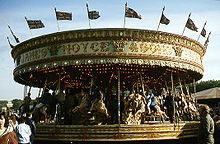- Nottingham Goose Fair
-
The Nottingham Goose Fair is an annual fun fair held in Nottingham, England, during the first week of October. It is largely provided by travelling fair people. It is one of only two established fairs in the United Kingdom to carry the name, the other smaller Goosey Fair being held in Tavistock, Devon.
Contents
History
The fair dates back more than 700 years and was once said to be Europe's biggest.[citation needed] Even today, it is second only to 'Tubby's Funfair' held in Penistone, Barnsley.[citation needed] The consensus among historians is that the fair probably started just after 1284, when the Charter of King Edward I referred to city fairs in Nottingham.[1] The Goose Fair was cancelled due to the bubonic plague in 1646 and again during the two World Wars in the 20th century. Until 1928 it was held in Old Market Square in Nottingham city centre, but it was moved because of redevelopment of the area.
The Goose Fair started as a trade event and enjoyed a reputation for its high-quality cheese, although it is now known for its rides and games.[citation needed] Its name is derived from the thousands of geese that were driven from Lincolnshire to be sold in Nottingham.
Originally, the fair was held on the 21st of September, but in 1752, with the change to the Gregorian calendar, it moved to early October. The duration of the fair was shortened from eight days to three days in the 1800s.
Recent history
Nottingham Goose Fair is considered by most to be one of the most prestigious fairs in the UK.[citation needed] However, in recent years, the dates of the fair have created a problem, as it now overlaps with the Hull Fair. Some of the top rides from the Goose Fair therefore have to travel directly from Nottingham to Hull, not opening at Hull until around the fourth day of the fair.
It is now held at the Forest Recreation Ground. After the turn of the 21st century its length was increased again to four days, for the 700th anniversary, and was kept like this afterwards. For 2006, the fair increased to five days with the addition of limited opening hours on the Sunday afternoon. However it proved unprofitable to open on the Sunday, so this was not repeated in 2007 although it was opened for 5 days again from 2009.
In art and popular culture
The Nottingham-based artist Arthur Spooner painted The Goose Fair, Nottingham in 1926.[2][3] The painting was sold at Christie's in 2004[4] and is now displayed in Nottingham Castle.
The book "English Journey" by J. B. Priestley contains an account of the author's visit to the Goose Fair in 1933.
The goose fair has been used in television programmes as well as in films such as The Woman for Joe and Saturday Night and Sunday Morning.
See also
- Bridgwater
- Tavistock, Devon 'Goosie Fair'
References
- ^ "History of Goose Fair". Nottingham City Council. Apr 2011. http://www.nottinghamcity.gov.uk/index.aspx?articleid=11351. Retrieved October 05, 2011.
- ^ "About 'The Goose Fair Nottingham'". Teacher Education. The National Gallery, London, UK. http://www.nationalgallery.org.uk/initial-teacher-education/primary/learning/spooner.aspx. Retrieved September 20, 2011.
- ^ "Notts treasures: Spooner's Goose Fair". Nottingham: Local History. BBC. May 2009. http://www.bbc.co.uk/nottingham/content/articles/2009/04/21/arthur_spooner_painting_nottingham_castle_feature.shtml. Retrieved September 20, 2011.
- ^ "Arthur Spooner (1873–1962): The Goose Fair, Nottingham". Christie's, London, UK. http://www.christies.com/Lotfinder/LotDetailsPrintable.aspx?intObjectID=4295763. Retrieved September 20, 2011.
External links
Categories:- Recurring events established in 1284
- 1284 establishments in England
- Festivals in England
- Culture in Nottingham
- History of Nottingham
- Annual fairs
- Medieval economics
- Fairs in England
- Annual events in the United Kingdom
- September events
- October events
Wikimedia Foundation. 2010.


